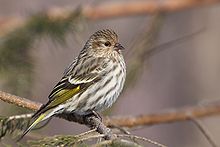
The true finches are small to medium-sized passerine birds in the family Fringillidae. Finches generally have stout conical bills adapted for eating seeds and nuts and often have colourful plumage. They occupy a great range of habitats where they are usually resident and do not migrate. They have a worldwide native distribution except for Australia and the polar regions. The family Fringillidae contains more than two hundred species divided into fifty genera. It includes the canaries, siskins, redpolls, serins, grosbeaks and euphonias, as well as the morphologically divergent Hawaiian honeycreepers.

The American goldfinch is a small North American bird in the finch family. It is migratory, ranging from mid-Alberta to North Carolina during the breeding season, and from just south of the Canada–United States border to Mexico during the winter.

The Eurasian siskin is a small passerine bird in the finch family Fringillidae. It is also called the European siskin, common siskin or just siskin. Other (archaic) names include black-headed goldfinch, barley bird and aberdevine. It is very common throughout Europe and Eurosiberia. It is found in forested areas, both coniferous and mixed woodland where it feeds on seeds of all kinds, especially of alder and conifers.
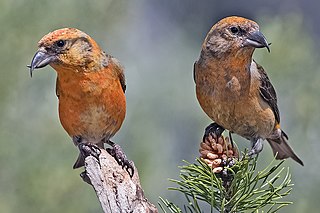
The red crossbill or common crossbill is a small passerine bird in the finch family Fringillidae. Crossbills have distinctive mandibles, crossed at the tips, which enable them to extract seeds from conifer cones and other fruits.

The pine grosbeak is a large member of the true finch family, Fringillidae. It is the only species in the genus Pinicola. It is found in coniferous woods across Alaska, the western mountains of the United States, Canada, and in subarctic Fennoscandia and across the Palearctic to Siberia. The species is a frugivore, especially in winter, favoring small fruits, such as rowans. With fruit-crop abundance varying from year to year, pine grosbeak is one of many subarctic-resident bird species that exhibit irruptive behavior. In irruption years, individuals can move long distances in search of suitable food supplies, bringing them farther south and/or downslope than is typical of years with large fruit crops.

The spotted nutcracker, Eurasian nutcracker, or simply nutcracker is a passerine bird slightly larger than the Eurasian jay. It has a much larger bill and a slimmer looking head without any crest. The feathering over its body is predominantly chocolate brown with distinct white spots and streaks. The wings and upper tail are virtually black with a greenish-blue gloss.
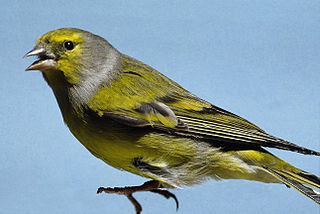
The citril finch, also known as the Alpine citril finch, is a small songbird, a member of the true finch family, Fringillidae.

The red siskin is a small endangered finch.
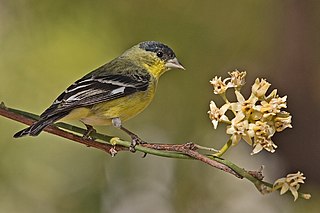
The lesser goldfinch is a very small songbird of the Americas. Together with its relatives the American goldfinch and Lawrence's goldfinch, it forms the New World goldfinch clade in the genus Spinus.

Lawrence's goldfinch is a small songbird of erratic distribution that breeds in California and Baja California and winters in the southwestern United States and northern Mexico.

The yellow-bellied siskin is a small passerine bird in the finch family Fringillidae. It breeds from Costa Rica south to southern Ecuador, central Bolivia and the highlands of northwestern Venezuela.

The British finches are made up of several species of finch which were formerly very popular as cage birds in Great Britain. They are not currently commonplace, but are still kept by a few dedicated fanciers.

The hooded siskin is a small passerine bird in the finch family (Fringillidae), native to South America. It belongs to the putative clade of neotropical siskins in the genus Spinus sensu lato.

The Drakensberg siskin is a small passerine bird in the finch family. It is an endemic resident breeder in the eastern Cape Province Transkei and western Natal in South Africa, and in Lesotho.

The olivaceous siskin is a species of finch in the family Fringillidae. It is found in Bolivia, Ecuador, and Peru, where its natural habitats are subtropical or tropical moist montane forests and heavily degraded former forest.

The saffron siskin is a species of finch in the family Fringillidae. It is found in Ecuador and Peru. Its natural habitats are subtropical or tropical dry forests, subtropical or tropical dry shrubland, and urban areas. It is threatened by habitat destruction and the IUCN has assessed it as being a "least concern species".
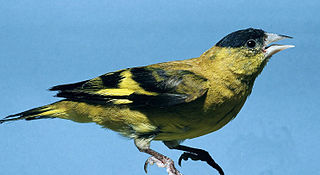
The Andean siskin is a species of finch in the family Fringillidae. It is found in Colombia, Ecuador, and Venezuela. Its natural habitats are subtropical or tropical moist montane forests, subtropical or tropical high-altitude shrubland, subtropical or tropical high-altitude grassland, and heavily degraded former forest.

The yellow-faced siskin is a species of finch in the family Fringillidae. It is found in Brazil and Venezuela.

The Tibetan serin or Tibetan siskin is a true finch species.

Spinus is a genus of passerine birds in the finch family. It contains the North and South American siskins and goldfinches, as well as two Old World species.
